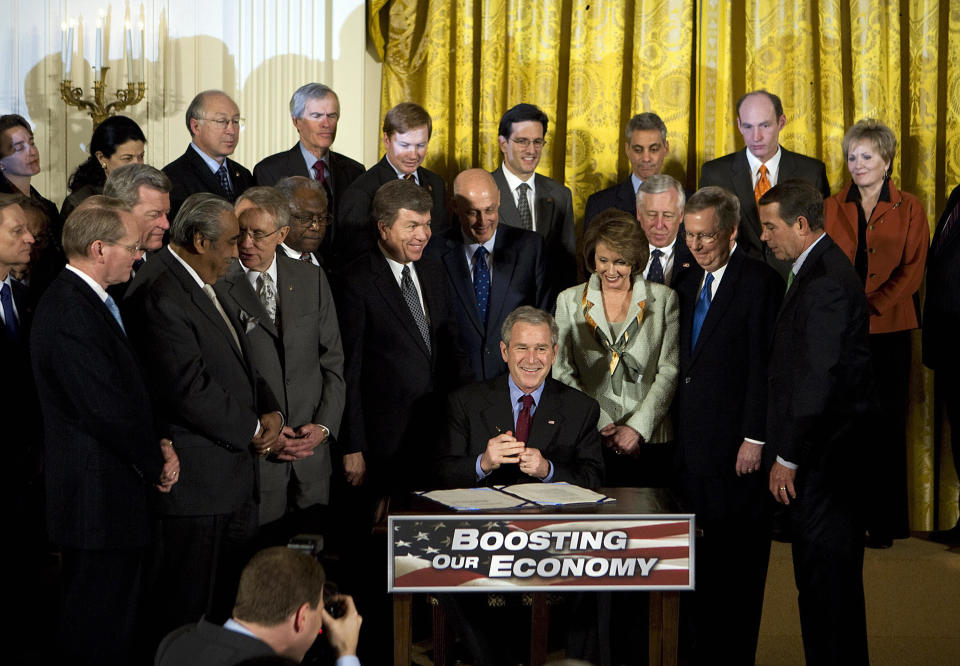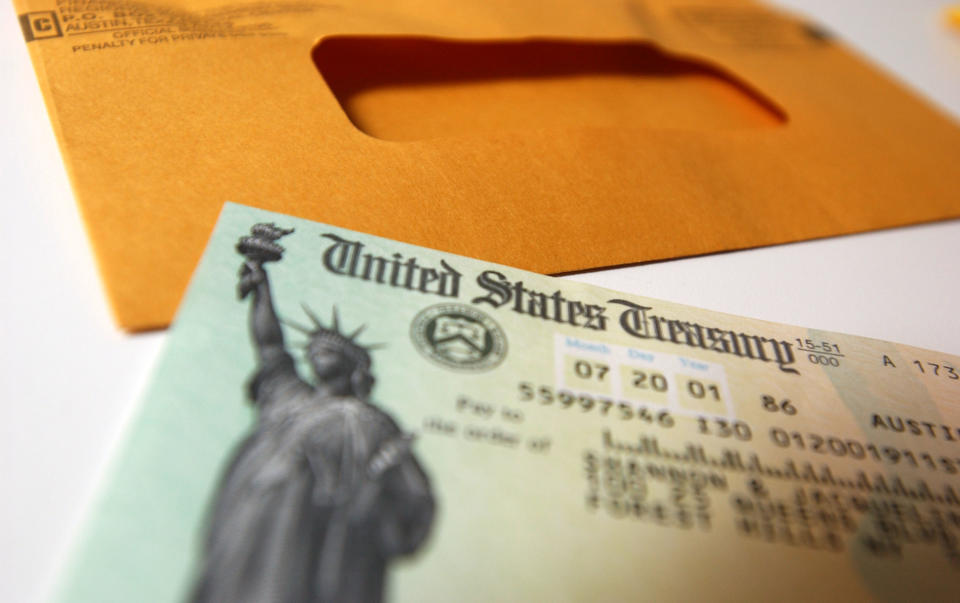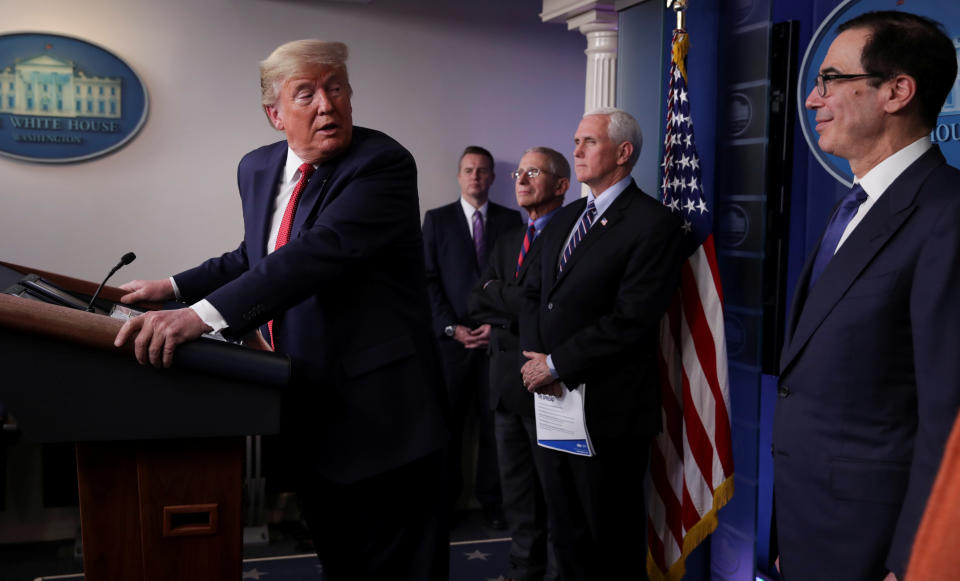Coronavirus checks may not stimulate the economy quickly, research suggests
Americans who make less than $99,000 annually are set to receive cash from the government in the coming weeks and months. The money, part of an $2+ trillion stimulus package amid the coronavirus pandemic, will total up to $1,200 per adult and $500 for children.
“People are going to be getting big checks,” President Trump said recently.
The key question, in terms of getting the economy moving quickly again, is how quickly they spend it.
In 2001, the government sent a retroactive tax rebate as part of President George W. Bush's tax legislation. Then, the 2008 Economic Stimulus Act included checks of $600 per individual with an additional $300 per dependent child.
“We have experience seeing the government trying to stimulate the economy in this way,” says Kevin Mumford, associate professor of economics at Purdue University, .
This ‘isn't the most effective way to get people to spend the money’
Mumford notes that the “experience from both of those previous episodes is that over the next initial three, four months, only about a quarter of the money the government sent out was spent.” He added: it “probably isn't the most effective way to get people to spend the money.”

In 2008, the University of Michigan surveyed Americans as that stimulus money was arriving. The resulting research found that much of the cash didn’t get spent in the immediate term. The survey found that about 20% of Americans used the money to “mostly spend.” Nearly 80% of respondents said that they either saved the money or used it to pay off debt (activities with much less stimulative effects for the economy).
“It was certainly less than what I had expected,” says Joel Slemrod, one of the authors of the study, in an interview. A lot of money, however, did get into the economy quickly – “it was a nontrivial boost for sure,” he says.
Early results this time around appear to be similar. A recent survey done by Money Done Right, an advice website featuring personal finance professionals, found 20% of Americans said they will use the cash for spending, while 67% said they’ll use it to pay off debt or save it, and 13% said they'll invest it.
“The way I think about it is that the right way to do this and how to evaluate this depends on what the objectives are,” Slemrod says. Are you trying to stimulate the macro economy or help the particular people who have been hurt? “They're not necessarily the same groups,” he says.
A slight counterpoint: More spending on ‘durable goods’ in 2008
Another study from 2011 by professors at Northwestern University and the University of Pennsylvania, found differences in how the spending played out.
Their research found that a fraction of the money (12%-30% of stimulus payments) was quickly spent on nondurable goods, i.e., products that are only usable for a short period of time like food and clothes, but it found higher spending (“50%-90% of the payments) quickly went to durable goods (home appliances, furniture). And on one good in particular: new cars. “In sum, receipt of a stimulus payment increased the probability of purchasing a vehicle,” the researchers wrote.
The researchers also looked at the response to the 2001 checks. They found similar results on non-durable goods: “no significant response of durable goods in 2001.”

One of the researchers, Nicholas Souleles, highlighted in an email that there was a sizable increase in spending among “the most illiquid people” – from the unemployed to those with low incomes, as well as higher earners who’ve maxed out their credit cards.
The data leads some, like Mumford of Purdue University, to push for increased unemployment benefits over direct checks.
Unemployment insurance, also part of the just-passed stimulus bill, is “a very effective way of getting the money to the people who are most likely to spend it because there are initial necessities that need to be purchased,” Mumford says.
The money will be arriving within weeks
On Sunday, Treasury Secretary Steve Mnuchin said Americans should start seeing the checks very soon. “We'll also have direct deposit into people's accounts within three weeks,” he said in a Fox News interview.

For those who don’t have direct deposit information on file with the IRS, it could take longer. The 2001 checks came over a 10-week period, while the 2008 checks, for those who didn’t have direct deposit, “were sent via mail from mid-May to mid-July,” according to the Tax Foundation.
What remains to be seen is whether the economic landscape is such that Americans are inclined to save their check or go out and spend it.
Both Professors Mumford and Slemrod are a bit skeptical that spending levels will be high this time.
“We are all being asked to stay at home and so it is harder to go out,” notes Mumford, adding “for many Americans, receiving the check is not going to be any sort of thing that makes a difference in their spending habits.”
Slemrod, who is currently designing a follow-up survey on this latest round of stimulus money, notes that “what's in my head is that in a month or two months [when the money has arrived], a lot of people are going to be having unpaid bills lying on their dining room table,” and so they might be more inclined to pay them off “as opposed to going out and spending more money.”
Ben Werschkul is a producer for Yahoo Finance in Washington, DC.
Read more:
Coronavirus crisis has exposed ‘raw underbelly’ issues in economy: expert
Here's what’s in the $2 trillion coronavirus stimulus deal for businesses
Public health expert: Now is the time to ‘double down on social distancing’
Read the latest financial and business news from Yahoo Finance
Follow Yahoo Finance on Twitter, Facebook, Instagram, Flipboard, LinkedIn, YouTube, and reddit.
